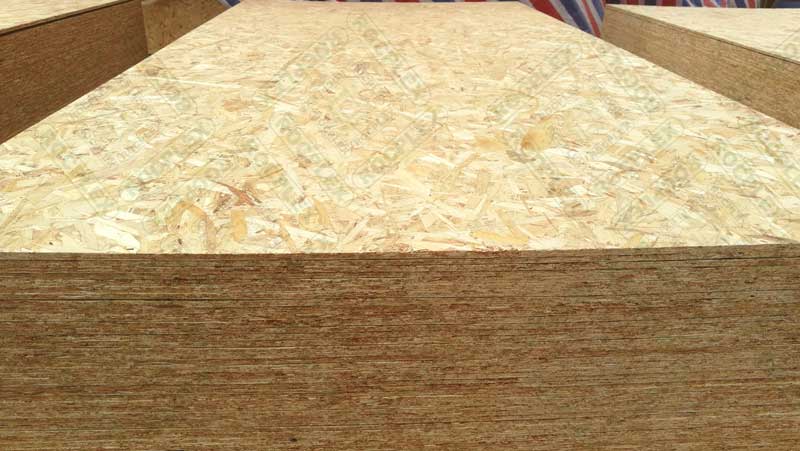OSB is made of large wooden shavings of specified shape and thickness after gluing and laying them in a directional manner, and then hot-pressed to form a multi-layer structure board, and the surface shavings are oriented along the length or width of the board.
As a structural board, OSB is gradually accepted by Chinese consumers because of its high strength (close to plywood), good dimensional stability, environmental protection, wide range of applications and good processing performance, which also promotes OSB in China. development of.
1. Preparation of OSB raw materials
Raw material preparation is one of the key processes in the production of OSB. After peeling and removing impurities from the wood raw material, it is processed into the shavings required for production. Usually, the length of the shavings used to produce OSB is 100-120 mm, the width is 20-50 mm, and the thickness is about 0.6 mm. .
Different from the large-diameter logs used in foreign OSB production, the sources of raw materials used to produce OSB in China are relatively wide and the types are relatively complicated. They are mainly small-diameter fast-growing logs and a large number of processing residues, such as poplar, eucalyptus and branch wood. Saw lumber leftovers, etc.
1.1. OSB long product flaker produces large shavings
The production of large shavings by ring-type long wood flaker is the traditional configuration of the material preparation process of the OSB production line. First, the logs are sent to the peeling machine for peeling. The peeled logs pass through the metal detector to remove the logs containing metal. The qualified logs enter the long wood The long wood planer batch feeder, and then sent to the cutting room of the long wood planer batch by batch to cut into shavings.
Commonly used long product planers mainly include knife ring type long product planer, cutter head type long product planer and knife shaft type long product planer, among which the application of knife ring long product planer is most widely. Knife ring type long product planer is composed of several parts such as batch feeding system, alignment mechanism, pressing fixture, mobile cutting chamber and main drive motor.
Its working principle is similar to that of sharpening a pencil with a pencil knife. After the log enters the cutting chamber, the cutting chamber of the long wood planer advances along the guide rail at a constant speed, and the internal rotating knife ring slices along the axis of the log. Directional and scoring knives to control the length, width and thickness of the shavings. The thickness of the shavings produced by the ring-type long wood flaker is relatively uniform, the shape of the shavings is good, and the output is high, which is suitable for large-capacity OSB production lines.
1.2. OSB two-section technology to produce large pieces of shavings
The emergence of two-stage OSB large-scale shaving production technology has changed the previous history of only using large-diameter wood in the production of OSB. Sub-small materials such as branch wood, bent wood, and sawn wood scraps can be used to process wood shavings that meet OSB production, making OSB raw materials The scope has been expanded, which has eased the shortage of raw materials for OSB manufacturers to a certain extent.
The two-segment shavings preparation technology is divided into two steps: the first step is to pass the wood raw materials through a specially designed chipper to produce large wood chips with a length of about 150 mm; the second step is to screen the cut large wood chips Remove impurities, and then process large flakes with a thickness of 0.6 mm and a length of about 150 mm through an optimized ring flaker.
Compared with the traditional long wood flaker, the length-thickness ratio of the shavings processed by the two-segment shaving preparation technology is better. In addition, unlike the rectangular shavings prepared by the long wood flaking machine, the edges of the shavings prepared by the two-stage flaking are irregular and not at right angles, and have a significantly more uniform tension transition.
2. Drying of OSB shavings
OSB dryers generally use single-channel dryers. The conventional medium-temperature drying technology can not only meet the drying requirements of conventional OSB shavings, but also be used for the mixed drying of fine shavings and flaky large shavings in OSB raw materials that can be decorated.
The entire drying process is divided into three stages: pre-drying section, drying section, and equalization section to ensure that the moisture content of the final shavings is controlled at about 2%. Utilizing the airflow of the outlet fan of the dryer, the fine shavings pass through the dryer quickly because of their small size and light weight;
Under the double action of the shovel inside the dryer and the airflow, the medium-sized shavings are in a free suspension state to complete the drying; while the large shavings are rotated along the inner wall of the dryer to complete the drying. The time and the route passed are relatively long, so that the moisture content of the shavings that finally come out of the dryer is uniform.
3. Sorting of OSB shavings
There are two forms of shavings sorting, one is to use mechanical methods to sort the shavings according to the geometric size through grids of different apertures or set gaps, and the other is to separate the shavings with different densities and suspension ratios by adjusting the airflow speed. sorting.
The shavings coming out of the dryer are generally divided into two ways, one is the large shavings that come down directly from the discharge box of the dryer, and the other is the fine shavings that are mixed in the drying tail gas and discharged and collected by the recycling cyclone. In order to improve the sorting efficiency, it is usually recommended to separate the two streams of shavings for screening.
Commonly used mechanical screening equipment for shavings screening includes drum screens, disc sieves, and swinging sieves. The selection of shavings screening equipment for OSB production lines depends on the production capacity and shape of the shavings.
4. Sizing of OSB shavings
The sorted shavings enter the dry shaving silo of the surface core layer respectively. In order to ensure that the shavings do not bridge in the silo, the material is discharged smoothly and the shape of the shavings is not damaged, the silo for storing the shavings is a specially designed horizontal material. warehouse.
There is a support rod in the center of the roller glue mixing machine, on which a certain number of atomizing heads are designed and installed), glue, paraffin emulsion, curing agent and other additives are mixed with the shavings in the glue mixing machine through the atomizing head.
The guide bar inlaid on the inner wall of the glue mixer brings the centrifugal force of the shavings rotating with the cylinder to the clockwise direction at 11:00. The shavings finish sizing during the free fall process, and the shavings in the glue mixer will follow the direction of the glue mixer. The rotation of the cylinder is brought up and down many times for repeated sizing.
5. Pavement of OSB shavings
The surface core shavings after glue mixing are sent to the surface core layer metering silo of the paving station, and then paved by each paving head. The traditional OSB pavement is a 3-layer structure pavement, that is, the upper and lower surface layers and the core layer. Among them, the paving method of the upper and lower surface layers is directional paving in the length direction, and the wide and long large shavings are directly paved on the surface layer; the paving method of the core layer is horizontal directional paving, and the finely divided sub-small shavings are paved on the core layer.
The weighing unit can be integrated at the bottom of the shavings metering silo, and the metering belt scale installed at the bottom of the pavement metering silo can adjust the feeding amount in time according to the deviation of the shavings bulk density change, so as to achieve precise control, which is directly completed by the paving head The chipboard pavement forms the slab structure.
Post time: Dec-19-2022


